Simultaneous Voltammetric Detection of Acetaminophen and Caffeine Base on Cassava Starch—Fe3O4 Nanoparticles Modified Glassy Carbon Electrode
Abstract
1. Introduction
2. Materials and Method
2.1. Materials
2.2. Preparation of MIP Membrane
2.3. Electrode Modifications
2.4. Cyclic Voltammetry (CV) and Differential Pulse Voltammetry (DPV) Measurements
3. Results and Discussions
3.1. Characterization of the Modified Electrode
3.2. Quantitative Analysis
4. Conclusions
Author Contributions
Funding
Acknowledgments
Conflicts of Interest
References
- Zhao, W.R.; Kang, T.F.; Lu, L.P.; Shen, F.X. A novel electrochemical sensor based on gold nanoparticles and molecularly imprinted polymer with binary functional monomers for sensitive detection of bisphenol A. J. Electroanal. Chem. 2017, 786, 102–111. [Google Scholar] [CrossRef]
- Guo, W.; Pi, F.; Zhang, H.; Sun, J.; Zhang, Y.; Sun, X. A novel molecularly imprinted electrochemical sensor modified with carbon dots, chitosan, gold nanoparticles for the determination of patulin. Biosens. Bioelectron. 2017, 15, 299–304. [Google Scholar] [CrossRef]
- Delgado, K.P.; Raymundo-Pereira, P.A.; Campos, A.M.; Oliveira, O.N., Jr.; Janegitz, B.C. Ultralow cost electrochemical sensor made of potato starch and carbon black nanoballs to detect tetracycline in waters and milk. Electroanalysis 2018, 30, 2153–2159. [Google Scholar] [CrossRef]
- Wattimena, D.; Ega, L.; Polnaya, F.J. Karakteristik edible film pati sagu alami dan pati sagu fosfat dengan penambahan gliserol. J. Agritech 2016, 36, 247–252. [Google Scholar]
- Maharani, Y.; Hamzah, F.; Rahmayuni, R. Pengaruh Perlakuan Sodium Tripolyphosphate (STPP) Pada Pati Sagu Termodifikasi Terhadap Ketebalan Ransparansi Dan Laju Perpindahan Uap Air Edible Film. Jom Faperta Unri 2017, 4, 1–10. [Google Scholar]
- Da Silva, N.; Sechi, M.; Teixeira, P.M. Preparation and physicochemical, structural and morphological characterization of phosphorylated starch. Mater. Res. 2017, 20, 174–180. [Google Scholar]
- Bhakat, D.; Barik, P.; Bhattacharjee, A. Electrical conductivity behavior of gum arabic biopolymer-Fe3O4 nanocomposites. J. Phys. Chem. Solids 2018, 112, 73–79. [Google Scholar] [CrossRef]
- Jayakrishnan, P.; Ramesan, M.T. Synthesis, characterization, electrical conductivity and material properties of magnetite/polyindole/poly(vinyl alcohol) blend nanocomposites. J. Inorg. Organomet. Polym. Mater. 2017, 27, 323–333. [Google Scholar] [CrossRef]
- Mulyasuryani, A.; Mustaghfiroh, A.M. Development of potentiometric phenol sensors by nata de coco membrane on screen-printed carbon electrode. J. Anal. Meth. Chem. 2019, 2019, 10. [Google Scholar] [CrossRef]
- Pramana, D.; Mulyasuryani, A.; Tjahjanto, R.T. Membranes of nata de coco-nanoparticles Fe3O4 for diazinon sensors. J. Pure App. Chem. Res. 2018, 7, 275–281. [Google Scholar] [CrossRef]
- Mustaghfiroh, A.M.; Mulyasuryani, A.; Andayani, U. Development of chlorpyrifos sensor using molecularly imprinted polymer (mip) polyvinyl alcohol (PVA)-Fe3O4 as receptor. J. Pure App. Chem. Res. 2019, 8, 31–39. [Google Scholar] [CrossRef]
- Mulyasuryani, A.; Prasetya, D.E.D. Development of Chemical sensor for detection of monosodium glutamate by polyvinyl alcohol-Fe3O4 membrane on screen printed carbon electrode. IOP Conf. Ser. Mater. Sci. Eng. 2019, 546, 032022. [Google Scholar] [CrossRef]
- Levent, M. HPLC Method for the analysis of paracetamol, caffeine, and dipyrone. Turk J. Chem. 2002, 26, 521–528. [Google Scholar]
- Damayanti, S.; Ibrahim, S.; Firman, K.; Tjahjono, D.H. Simultaneous determination of paracetamol and ibuprofen mixtures by high performance liquid chromatography. Indonesian. J. Chem. 2003, 3, 9–13. [Google Scholar] [CrossRef]
- Fathalla, B.; Omar, M.A.; Derayea, S.; Zayed, S.; Hammad, M.A.; Saleh, S.F. Simultaneous determination of paracetamol, caffeine and codeine in tablets and human plasma by micellar liquid chromatography. Europ. J. Chem. 2015, 6, 468–474. [Google Scholar]
- Alagarsamy, P.; Settu, R.; Chen, S.M.; Chen, T.W.; Hong, I.S.; Rao, M.M. Amperometric determination of acetaminophen (paracetamol) using graphene oxide modified glassy carbon electrode. Int. J. Electrochem. Sci. 2018, 13, 7930–7938. [Google Scholar] [CrossRef]
- Fernandez, C.; Heger, Z.; Kizek, R.; Ramakrishnappa, T.; Borun, A.; Faisal, N.H. Pharmaceutical Electrochemistry: The electrochemical oxidation of paracetamol and its voltammetric sensing in biological samples based on screen printed graphene electrodes. Int. J. Electrochem. Sci. 2015, 10, 7440–7452. [Google Scholar]
- Mao, A.; Li, H.; Jin, D.; Yu, L. Fabrication of electrochemical sensor for paracetamol based on multi-walled carbon nanotubes and chitosan–copper complex by self-assembly technique. Talanta 2016, 144, 252–257. [Google Scholar] [CrossRef]
- Hasanpour, F.; Taei, M.; Tahmasebi, S. Ultra-sensitive electrochemical sensing of acetaminophen and codeine in biological fluids using CuO/CuFe2O4 nanoparticles as a novel electrocatalyst. J. Food. Drug Anal. 2018, 26, 879–886. [Google Scholar] [CrossRef]
- Song, X.; Fu, J.; Wang, J.; Li, C.; Liu, Z. Simultaneous voltammetric determination of acetaminophen and dopamine using a glassy carbon electrode modified with copper porphyrin-exfoliated graphene. Microchim. Acta 2018, 185, 369. [Google Scholar] [CrossRef]
- Mahmoud, B.G.; Khairy, M.; Rashwan, F.A.; Banks, C.E. Simultaneous voltammetric determination of acetaminophen and isoniazid (hepatotoxicity-related drugs) utilizing bismuth oxide nanorod modified screen-printed electrochemical sensing Platforms. Anal. Chem. 2017, 89, 2170–2178. [Google Scholar] [CrossRef] [PubMed]
- Khairy, M.; Mahmoud, B.G.; Banks, C.E. Simultaneous determination of codeine and its co-formulated drugs acetaminophen and caffeine by utilising cerium oxide nanoparticles modified screen-printed electrodes. Sens. Actuator B Chem. 2018, 259, 142–154. [Google Scholar] [CrossRef]
- Amare, M. Voltammetric determination of paracetamol in tablet formulation using Fe(III) doped zeolite-graphite composite modified GCE. Heliyon 2019, 5, e01663. [Google Scholar] [CrossRef] [PubMed]
- Ortiz-Aguayo, D.; Bonet-San-Emeterio, M.; del Valle, M. Simultaneous voltammetric determination of acetaminophen, ascorbic acid and uric acid by use of integrated array of screen-printed electrodes and chemometric tools dionisia. Sensor 2019, 19, 3286. [Google Scholar] [CrossRef]
- Tadesse, Y.; Tadese, A.; Saini, R.C.; Pal, R. Cyclic Voltammetric Investigation of Caffeine at Anthraquinone Modified Carbon Paste Electrode. Int. J. Electrochem. 2013, 2013, 7. [Google Scholar] [CrossRef]
- Redivo, L.; Stredanský, M.; De Angelis, E.; Navarini, L.; Resmini, M.; Švorc, L. Bare carbon electrodes as simple and efficient sensors for the quantification of caffeine in commercial beverages. R. Soc. Open Sci. 2018, 5, 172146. [Google Scholar] [CrossRef]
- Ören, T.; Anık, Ü. Voltammetric determination of caffeine by using gold nanoparticle-glassy carbon paste composite electrode. Measurement 2017, 106, 26–30. [Google Scholar] [CrossRef]
- Amare, M.; Aklog, S. Electrochemical determination of caffeine content in Ethiopian coffee samples using lignin modified glassy carbon electrode. J Anal. Methods Chem. 2017, 2017, 3979068. [Google Scholar] [CrossRef]
- Tyszczuk-Rotko, K.; Szwagierek, A. Green electrochemical sensor for caffeine determination in environmental water samples: The bismuth film screen-printed carbon electrode. J. Electrochem. Soc. 2017, 164, B342–B348. [Google Scholar] [CrossRef]
- Hernandez-Aldave, S.; Tarat, A.; McGettrick, J.D.; Bertoncello, P. Voltammetric detection of caffeine in beverages at nafion/graphite nanoplatelets layer-by-layer films. Nanomaterials 2019, 9, 221. [Google Scholar] [CrossRef]
- Farag, A.S.; Pravcová, K.; Česlová, L.; Vytřas, K.; Sýs, M. Simultaneous determination of caffeine and pyridoxine in energy drinks using differential pulse voltammetry at glassy carbon electrode modified with Nafion®. Electroanalysis 2019, 31, 1494–1499. [Google Scholar] [CrossRef]
- Taher Alizadeha, T.; Ganjalib, M.R.; Zareb, M.; Norouzi, P. Development of a voltammetric sensor based on a molecularly imprinted polymer (MIP) for caffeine measurement. Electrochim. Acta 2010, 55, 1568–1574. [Google Scholar] [CrossRef]
- Salles, M.O.; Araujo, W.R.; Paixão, T.R. Development of a Molecularly Imprinted Modified Electrode to Evaluate Phenacetin Based on the Preconcentration of Acetaminophen. J. Braz. Chem. Soc. 2016, 27, 54–61. [Google Scholar] [CrossRef]



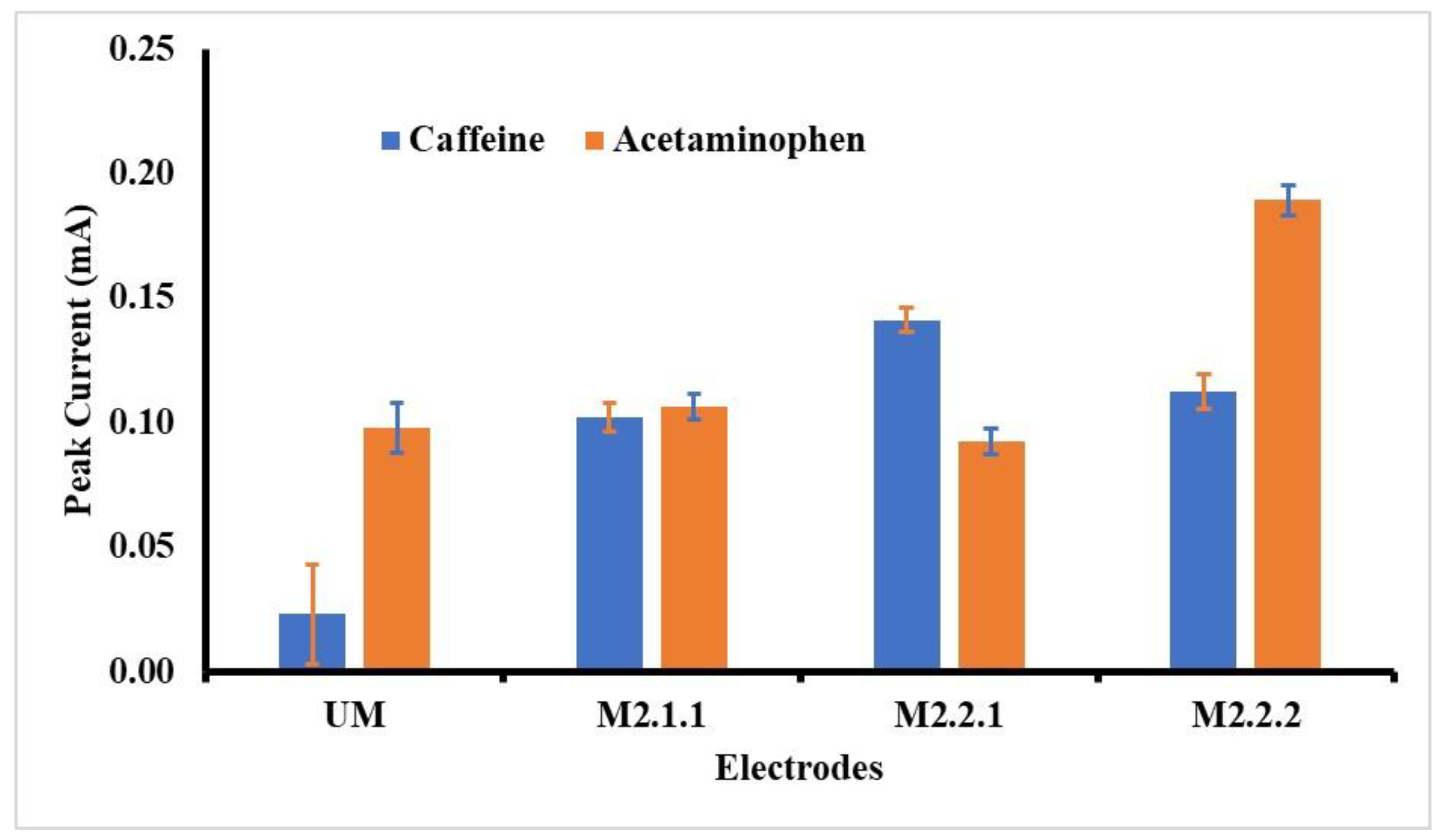
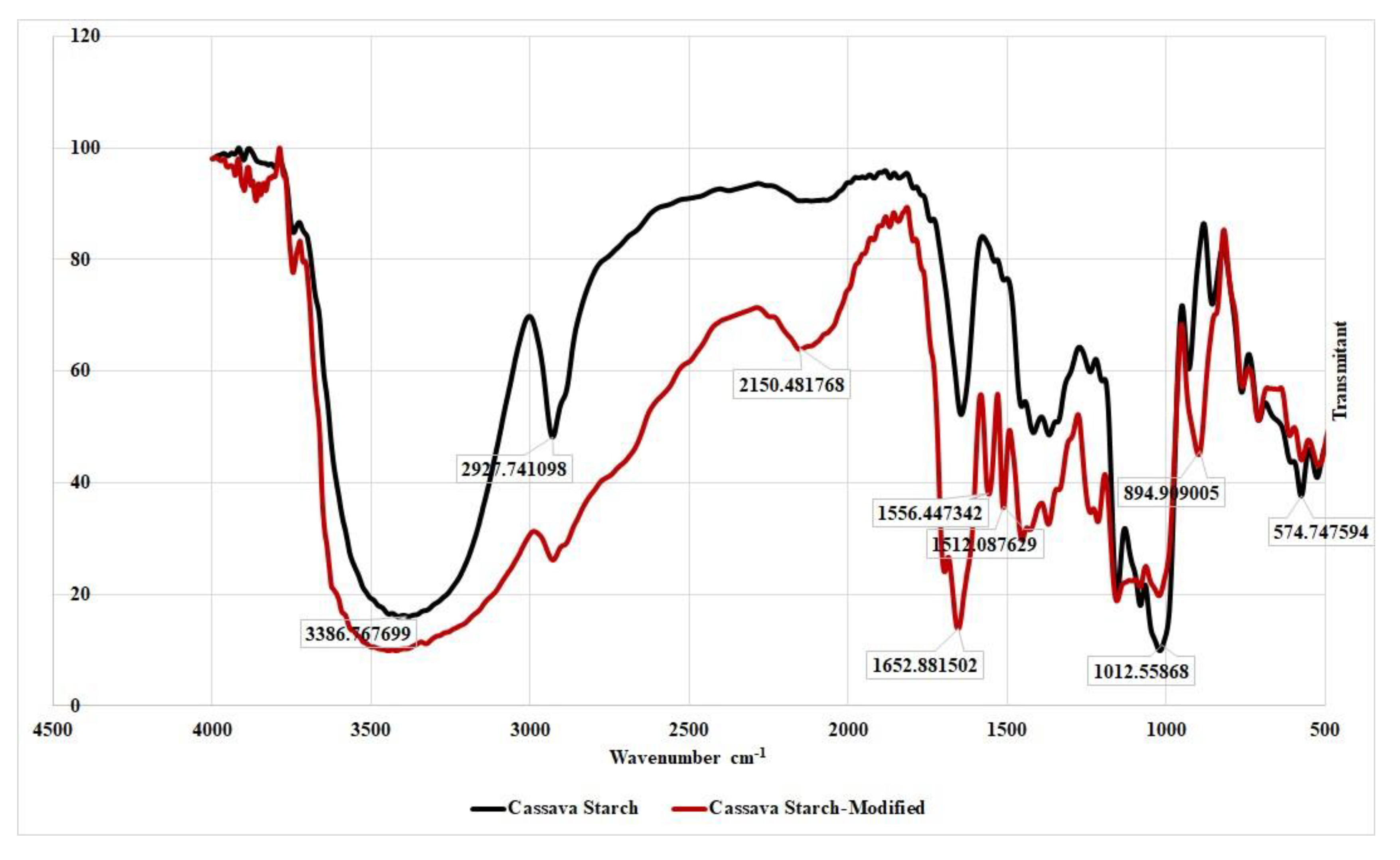

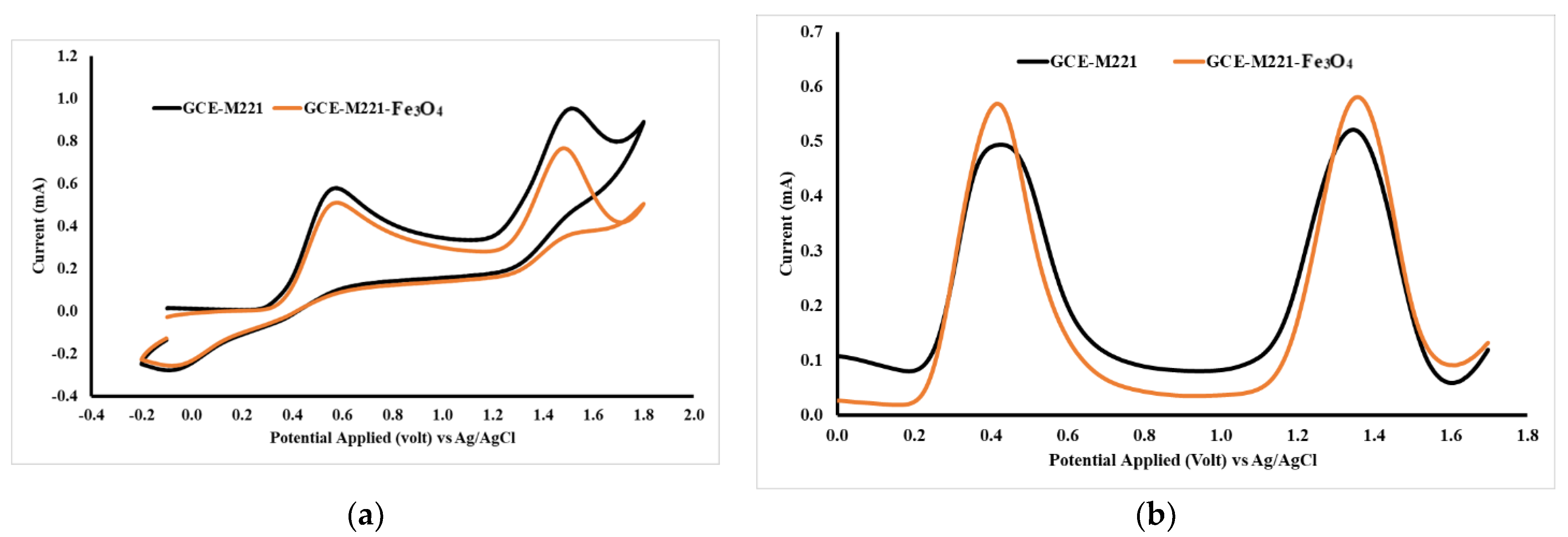

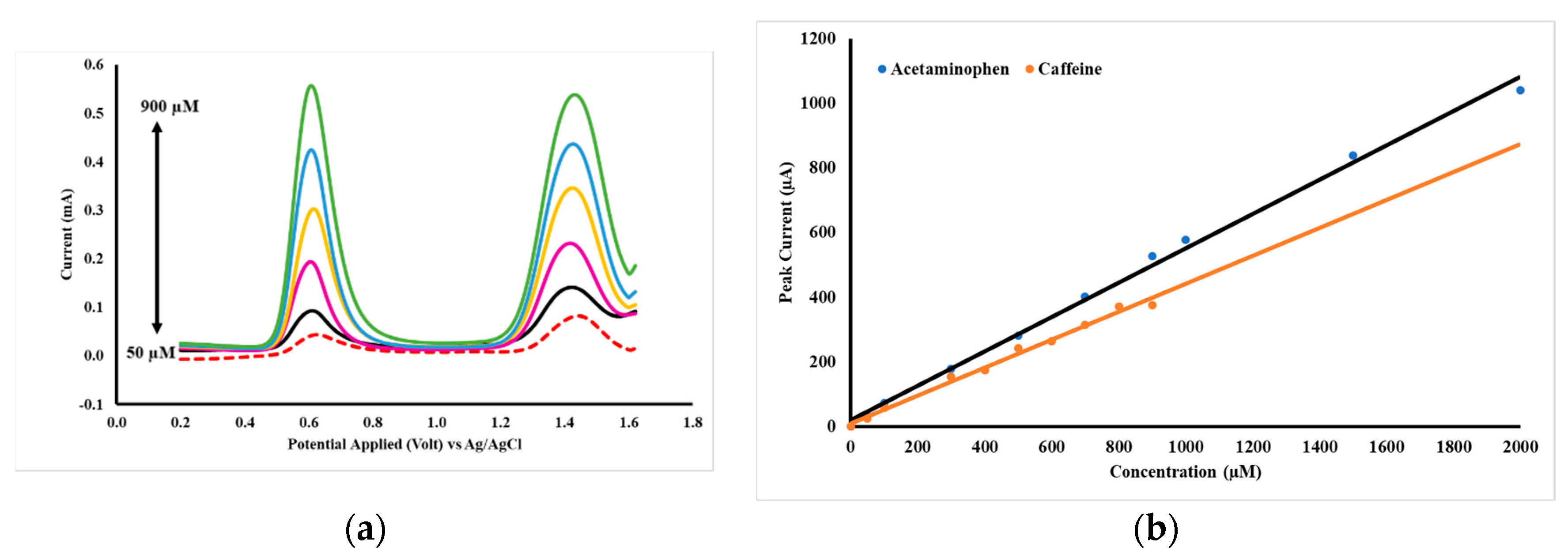
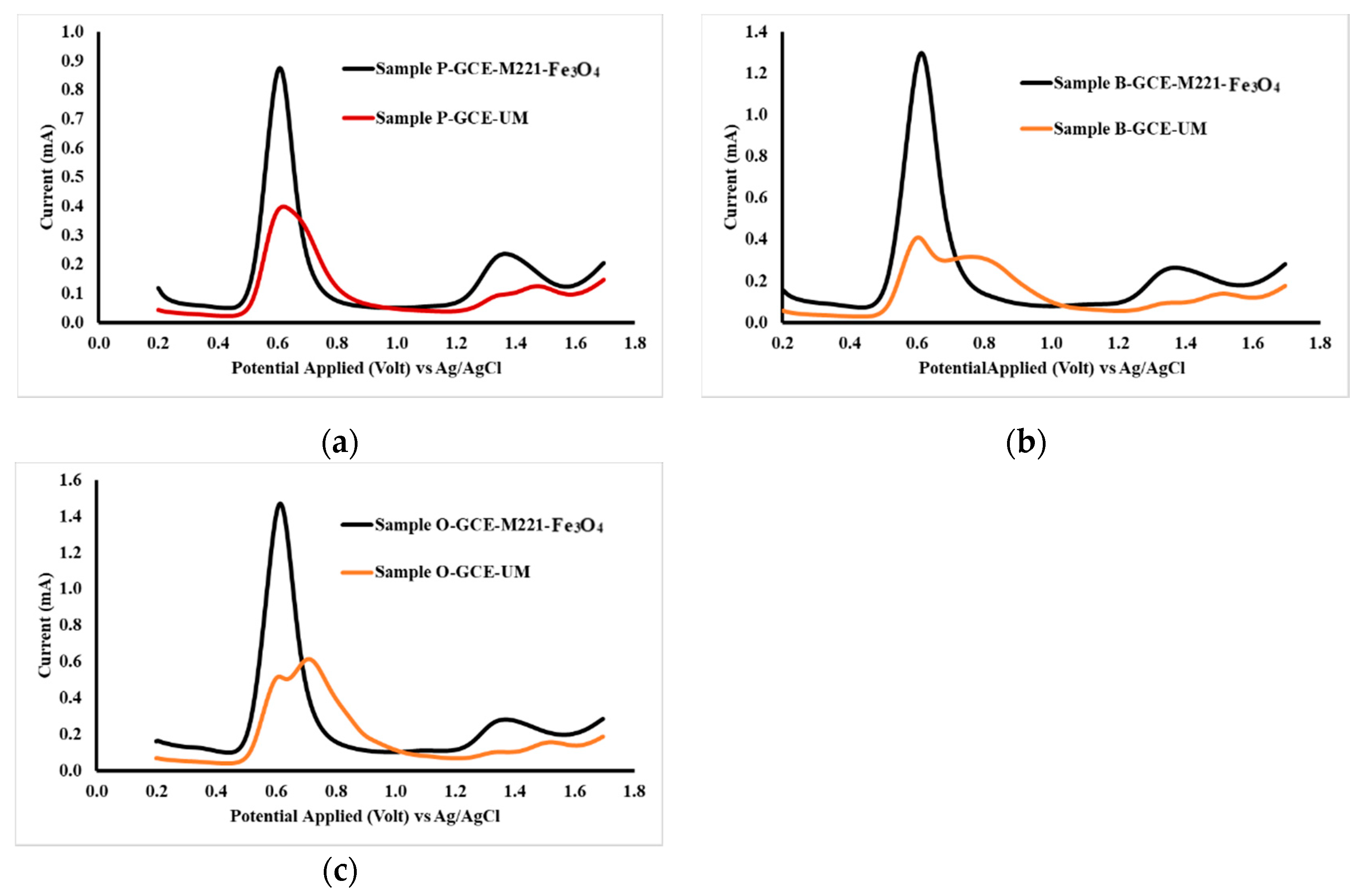
| Membranes | Percentage/(w/v) | |||
|---|---|---|---|---|
| Cassava Starch | STPP | Acetaminophen | Caffeine | |
| M211 | 2 | 1 | 1 | 1 |
| M221 | 2 | 2 | 1 | 1 |
| M222 | 2 | 2 | 2 | 2 |
| Electrode | Peak Potential/(volt) vs. Ag/AgCl | |
|---|---|---|
| Acetaminophen | Caffeine | |
| GCE-UM | 0.646057 | 1.47186 |
| GCE-M211 | 0.661163 | 1.45676 |
| GCE-M221 | 0.630951 | 1.45676 |
| GCE-M222 | 0.630951 | 1.45676 |
| pH | Ep/(Volt) vs. Ag/AgCl | Ip/(µA) | ||
|---|---|---|---|---|
| Acetaminophen | Caffeine | Acetaminophen | Caffeine | |
| 2 | 0.6215 | 1.4452 | 598 | 637 |
| 3 | 0.5711 | 1.4351 | 582 | 468 |
| 4 | 0.5216 | 1.4099 | 396 | 455 |
| 5 | 0.4712 | 1.3998 | 428 | 457 |
| 6 | 0.4166 | 1.3948 | 542 | 506 |
| 7 | 0.4079 | 1.3847 | 544 | 519 |
| Compounds | Ep/(volt) | Ip/(µA) | ||
|---|---|---|---|---|
| BR | PB | BR | PB | |
| Acetaminophen | 0.6445 | 0.6647 | 444 | 425 |
| Caffeine | 1.4746 | 1.4855 | 438 | 610 |
| No | Parameters | Compound | |
|---|---|---|---|
| Acetaminophen | Caffeine | ||
| 1 | Linear range concentration/(µM) | 50–2000 | 50–900 |
| 2 | Sensitivity/(A/M) | 0.5306 | 0.4314 |
| 3 | Limit of Detection/(µM) | 16 | 23 |
| Sample | Real mg/tablet | Recovery mg/tablet | Recovery (%) | |||
|---|---|---|---|---|---|---|
| Acet * | Caffeine | Acet * | Caffeine | Acet * | Caffeine | |
| P | 600 | 65 | 591 | 64 | 98.50 ± 1.20 | 98.40 ± 2.02 |
| B | 600 | 50 | 587 | 48 | 97.83 ± 1.02 | 97.74 ± 1.95 |
| O | 500 | 35 | 480 | 34 | 96.11 ± 0.90 | 98.66 ± 2.56 |
© 2019 by the authors. Licensee MDPI, Basel, Switzerland. This article is an open access article distributed under the terms and conditions of the Creative Commons Attribution (CC BY) license (http://creativecommons.org/licenses/by/4.0/).
Share and Cite
Mulyasuryani, A.; Tjahjanto, R.T.; Andawiyah, R. Simultaneous Voltammetric Detection of Acetaminophen and Caffeine Base on Cassava Starch—Fe3O4 Nanoparticles Modified Glassy Carbon Electrode. Chemosensors 2019, 7, 49. https://doi.org/10.3390/chemosensors7040049
Mulyasuryani A, Tjahjanto RT, Andawiyah R. Simultaneous Voltammetric Detection of Acetaminophen and Caffeine Base on Cassava Starch—Fe3O4 Nanoparticles Modified Glassy Carbon Electrode. Chemosensors. 2019; 7(4):49. https://doi.org/10.3390/chemosensors7040049
Chicago/Turabian StyleMulyasuryani, Ani, Rachmat Triandi Tjahjanto, and Robi’atul Andawiyah. 2019. "Simultaneous Voltammetric Detection of Acetaminophen and Caffeine Base on Cassava Starch—Fe3O4 Nanoparticles Modified Glassy Carbon Electrode" Chemosensors 7, no. 4: 49. https://doi.org/10.3390/chemosensors7040049
APA StyleMulyasuryani, A., Tjahjanto, R. T., & Andawiyah, R. (2019). Simultaneous Voltammetric Detection of Acetaminophen and Caffeine Base on Cassava Starch—Fe3O4 Nanoparticles Modified Glassy Carbon Electrode. Chemosensors, 7(4), 49. https://doi.org/10.3390/chemosensors7040049





